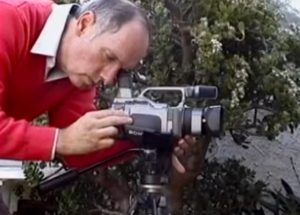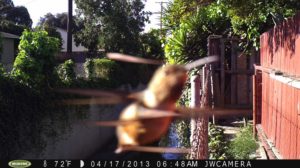This is not primarily about living pterosaurs or long-tailed ropens or flying dragons. We now disrobe video artifacts called flying rods, strange-looking objects that are not visible, as such, to the naked eye. Why examine such a subject on the Live Pterosaur blog rather than on a video-technology blog? This post does indirectly relate to modern pterosaurs. The television show Monsterquest may have made an error of judgment in two episodes, one of which was about reports of living pterosaurs.
- “Unidentified Flying Creatures” (Season 1, Episode 11) examines videotaped “rods,” which some persons believe to be paranormal
- “Flying Monsters” (Season 3) expedition on New Britain Island, Papua New Guinea (with a pterosaur-expert of a paleontologist)
Before we get into the nature of that error of judgment, and how it is common to both TV episodes, we need to carefully examine the one about “flying rods,” from the first season of Monsterquest.
Video Artifacts Called “Rods”
I was a forensic videographer in 2003, when I started a serious investigation into eyewitness reports of apparent pterosaurs. I understood the basics of NTSC video technology, which technology was still relevant at the time.
Jonathan Whitcomb, certified forensic videographer
Many persons may have both of the following misconceptions about video recording, and even some professional videographers may have a problem with one of them:
- Video accurately records appearances of all objects in moments of time
- Video often records what the human eye cannot see
Both of those concepts are generally wrong, or at least of limited value, although we can find exceptions. The problem with a paranormal interpretations of flying rods, however, is that it may require assuming we’re dealing with exceptions involving both of the above ideas. Please note:
Beware of putting too much confidence in the strength of a chain of connected assumptions.

“Flying rods” are NOT video recordings of creatures with more than four wings
Before digging more deeply into the apparent mystery of flying rods, let me give examples of images captured by my game camera a few years ago, in Lakewood, California. For information on the sighting that inspired me to put up that deer camera over a storm channel, see Flying Creature in Southern California.
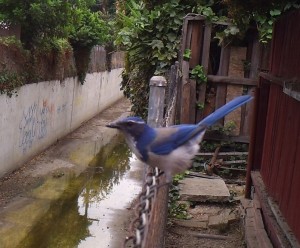
#1 Common bird on a fence by a storm channel in Lakewood, California
.

#2 What are those horizontal lines on the right?
.
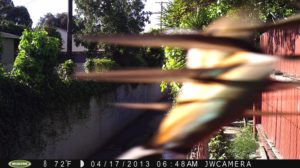
#3 What is that thing in front of the camera lens?
.
#4 Now it’s possible to see a hummingbird (Lakewood, California)
.
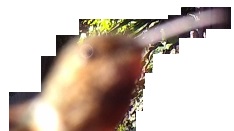
Head and beak of the hummingbird (from #4)
Notice how much easier it can be to discern the hummingbird head when the strange horizontal wing-flap lines are removed: The beak is no longer camouflaged. By the way, the above images, from the game camera in Lakewood, California, are not from a video camera but are still photos. Both kinds of cameras can record anomalies.
Remember misconception #1: “Video accurately records appearances of all objects in moments of time.” Neither photographic stills nor video stills are recordings of instantaneous moments. It always takes time for a number of photons of light to enter the camera lens and make the necessary impression on the recording device. No recording is instantaneous, no matter how fast the device may be, even with the most-high-speed equipment.
Whether we use a still camera or a video camera, when the relative speed of an object is great, in front of the lens, strange recordings can take place. These weird images are not limited to hummingbirds, for some insects flap their wings very rapidly, and that’s where “flying rods” come into view. Insects that are flapping their wings very quickly—they can make for some strange recordings on video, especially when an insect has flown close to the lens of the camera.
Insect Wing Flapping
According to Teacher-Scholastic (“How Insects Fly”):
Large-bodied insects lift off by flapping their wings very rapidly: for bees and flies, about 200 times per second. Some midges and wasps flap their wings up to 1,000 times per second!
What impressive wing-flapping rates! So what would we expect a common video camera to record, when such an insect flies across the field of view, relatively close to the lens? On playback, we should see a flying rod, either straight or curved, with many wing-like appendages on the sides. In fact, that’s what some persons show us while supporting a paranormal interpretation of such images from video footage.
The commonsense interpretation, however, is that those images are recordings of common flying creatures such as insects and birds. Some of those common creatures just flap their wings faster and fly closer to the camera.
Now let’s examine the common error in the two Monsterquest episodes, a fundamental error.
Bias Favoring Popular Imagination
What do these two Monsterquest episodes have in common? The obvious relationship is in the possibility of strange flying creatures, found in both episodes. The less-obvious similarity is found after digging deeper.
Bias in favor of one extreme or another—paranormal or commonplace explanation—that’s not the common problem. In the first-season episode “Unidentified Flying Creatures,” both extremes are given attention, ending with a wishy-washy appeal to each viewer to make a personal choice of preference; in the third-season episode “Flying Monsters,” both extremes are also given attention, ending with a ridiculous conclusion: Eyewitness accounts of giant flying creatures (at least some of which reportedly glow), including unidentified flying creatures that can carry away humans—those unclassified apparent gigantic animals relate to a tiny bat that one of the explorers was shown to hold in his hand. But the drum roll in the music background failed to convince many viewers that catching that tiny bat answered all questions about reports of giant flying creatures.
Now to the point about a similar bias in both television episodes of Monsterquest: They both give preference to popular imagination over human experience.
In the “flying rods” first-season episode, undue credit is given to the opinions of those who imagine an other-worldly cause of the strange images. What about the humans who were present at the time of the video recordings? They noticed nothing unusual, although some of them were aware of common birds and insects flying around at the time. Why assume that the flying rods were invisible to those humans? Why not consider that nothing unusual was flying around, just birds and insects?
In the “Flying Monsters” third-season episode, undue credit is given to the opinions of those who image universal extinctions of all species of pterosaurs. What about humans who witness living pterosaurs? In Searching for Ropens and Finding God, it says, “Trust one eyewitness of a plane crash over the imaginations of a hundred professors who’ve agreed how that kind of plane should fly.” Keeping within that symbolism, we should reject the proclamation of a hundred professors who believe that the plane could not possibly crash, and we should accept the eyewitnesses who saw the crash. By so doing, we can see clearly enough to recognize the smoke from the crash and rush to the scene, with hope of rescuing survivors.
###
.
Monsterquest versus Destination Truth
Regarding searching for the ropen with an open mind, Destination Truth wins easily against Monsterquest. Josh Gates interviewed a number of native eyewitnesses, one of them twice.
Unidentified Flying Creatures and Missing Persons
People go missing for a number of reasons. The following relates to some of the strangest cases, with an explanation that may shock many and appear unbelievable to others.
Many of the eyewitness reports come from the Southwest Pacific, including Papua New Guinea, Australia, and Indonesia; but some come from Africa, South America, North America, and Europe.
How common is a long tail on a modern pterosaur! Of the 128 more-credible sighting reports compiled at the end of 2012, 41% reported a long tail. That’s a lot, considering some eyewitnesses concentrate on the head or wings and don’t remember for sure if there was a long tail. Also significant is how few report the absence of a long tail: only 2%. That makes a 20-to-1 ratio in favor of long tails.
Fiery Flying Serpent of the Bible
Was the deadly “fiery flying serpent” of the Bible related to the modern ropen? That’s a difficult question, but it’s worthy of consideration.
UFC – Unidentified Flying Creature
Concerning the disappearance of eight-year-old Dennis Johnson, in Yellowstone National Park in 1966, a newspaper quoted one of the searchers: “It was nearly as if he had been snatched from the face of the earth.” Others have made similar statements about strange disappearances.
.



